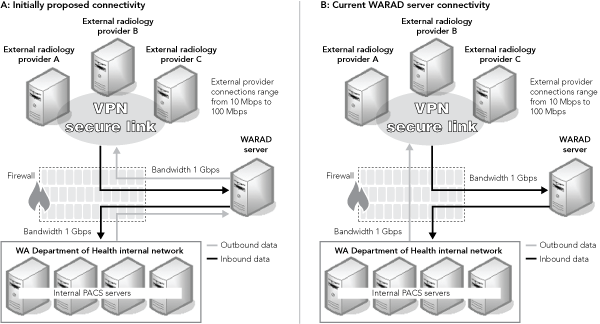The pilot project was funded by an initial grant of $100 000 from the DoH. To implement the project, the working group initially proposed to set up a dedicated server, the Western Australian Radiology (WARAD) server outside the DoH firewall (in the “demilitarised zone” [DMZ]) that could receive images from the private sector for retrieval by the public hospital PACS. Similarly, the public hospital PACS could send images to the WARAD server for retrieval by the private sector (Box, A). However, because of security issues, an alternative model was developed whereby the WARAD server could receive images from the private sector for the public system but images for the private sector would be sent directly to the private provider’s network via secure virtual private network (VPN) links (Box, B). The VPN provides an exclusive link to the WARAD server, which is more secure than transferring data via a public internet connection.
The pilot project was completed in May 2008. A similar exchange of digital images was introduced in Pennsylvania, United States, in 2006,1 but, to our knowledge, the system described here is the first successful link between public and private PACSs in Australia.
An audit trail regarding use of the shared system and objective evidence of reduction in radiation exposure (by eliminating repeat examinations) is being collected and will hopefully be published within the next 2 years. However, there is anecdotal evidence of reduction in repeat examinations.2
Initially proposed Western Australian Radiology (WARAD) server system compared with current system*
- Turab Chakera1
- Yusuf Nagree2
- Swithin Song1
- Philip Jones3
- 1 Department of Imaging, Royal Perth Hospital, Perth, WA.
- 2 Armadale–Kelmscott Memorial Hospital, Perth, WA.
- 3 Western Australian Department of Health, Perth, WA.
We would like to thank the WA DoH and many other people in both the public and private hospitals and clinics whose support and help has been instrumental in bringing the venture to fruition.
None identified.
- 1. Menschik ED. Cross-town cooperation. Imaging Econ 2006; 19: 35-38. http://www.imagingeconomics.com/issues/articles/2006-02_08.asp (accessed Sep 2009).
- 2. Sung JC, Sodickson A, Ledbetter S. Outside CT imaging among emergency department transfer patients. J Am Coll Radiol 2009; 6: 626-632.






Abstract
The delay in transfer of imaging studies when a patient moves between hospitals and between public and private systems has been a barrier to expedient and safe patient management.
There is also suboptimal reporting when patients have serial imaging undertaken partly in the private sector and partly in the public sector, because of inability to access previous imaging for comparison.
Availability of a DICOM (Digital Imaging and Communications in Medicine) server enables sharing of health information, including imaging data, across various sites and jurisdictions.
In Perth, Western Australia, we have successfully introduced electronic image transfer between five public teaching hospitals and three large private practices with different picture archiving and communication systems.